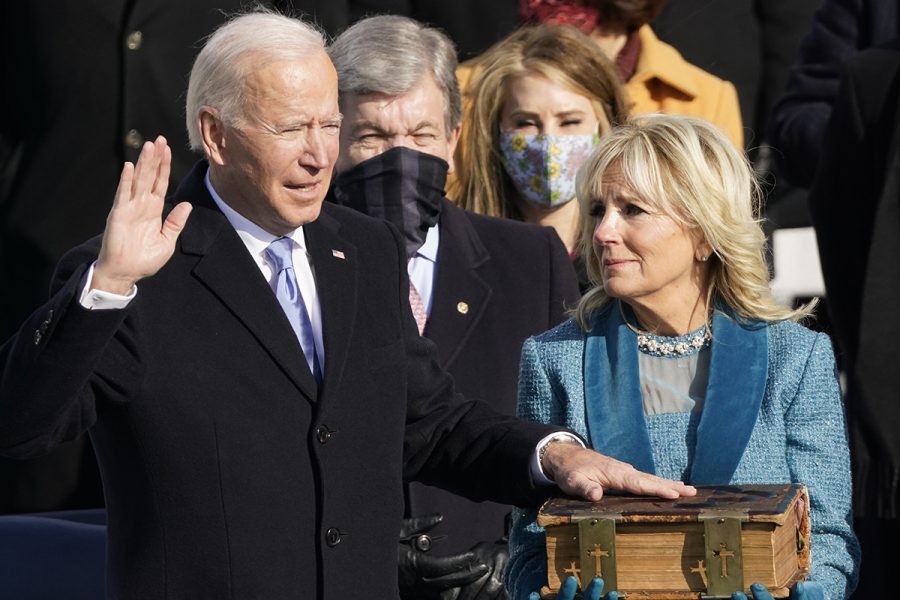A Guide to the First 144 Hours of the Biden Administration
Photo courtesy of Episcopalian News Service.org
January 25, 2021
Wednesday, January 20 marked a day of national ambivalence, the end to a Presidential term unprecedented in every sense of the word, and a demonstration of the resilience of American democracy. The months preceding the inauguration were consistently characterized by national division, loss, and landmarks – ranging from disputes over the election’s integrity to the heightened racial climate to the insurrection at the Capital to the 25 million national cases of coronavirus. Joe Biden and his administration have inherited a country deeply defined by institutional racism, polarizing politics, and a worsening healthcare crisis. A week before his inauguration, Biden unveiled a legislative package seeking to change the course of the pandemic, roll back Trump’s environmental actions, advance racial equity, and create a bridge to economic recovery. Within 144 hours of holding Presidential office, Biden has utilized the tool of Executive Orders to repeal acts of the previous administration and implement temporary solutions.
Day One: Biden issued a memorandum freezing approval of rules passed in Trump’s final days, requiring that these be reviewed by department and agency heads. Overturning Trump’s 2017 withdrawal, Biden returned the United States to the Paris Agreement on climate change: an international pact focusing on reducing emissions that contribute to global warming. He addressed a vital issue in the nation through the promotion of racial equity, in which he ordered the government to perform ‘equity assessments’ of its agencies and distribute resources to advance equity, focusing on minorities and people of color. Further diminishing Trump’s legacy, Biden reversed the travel ban that barred entry to the United States from seven Muslim countries. Although the President is unable to institute a mask mandate, he implemented an order mandating compliance with health regulations on federal properties and encouraging masking nationwide. In response to the pandemic, Biden created the position of Covid-19 response coordinator to oversee supply distribution and advise the President. He vowed to protect border security and address the implied humanitarian challenges, evoking a policy that targeted communities shielding undocumented immigrants. Eliminating multiple of Trump’s executive actions, Biden removed regulatory restrictions on federal agencies and now requires all government appointees to sign an ethics pledge. He reinstated undocumented immigrant’s inclusion in the census, overturning Trump’s attempt to exclude them. Biden revoked the permit for the Keystone XL pipeline, which was intended to cut through Indigenous lands to carry crude oil from Canada to the U.S., and paused oil/gas leasing in the Arctic National Wildlife Refuge. Lauded by LGBTQ+ advocates, Biden issued an order to expand protections against discrimination in federal agencies on the basis of sexual orientation, gender identity, and gender expression. He terminated the construction/funding of the border wall, a key promise of the Trump campaign. Biden requested an extension of the freeze on federal student loan payments, blocked the deportation of Liberian refugees living in the United States, and reaffirmed the DACA program, shielding undocumented immigrants who arrived as children from deportation.
Day Two: Addressing the pandemic, Biden mandated masking on all public transportation, increased support for critical/long-term care facilities and Covid-19 research, and promoted data-driven response. He directed the Secretaries of Defense and Homeland Security to support governors’ use of the National Guard in Covid-19 response, as well as requested department heads to assess the nationwide availability of resources to strengthen the public health supply chain. Biden has created the Covid-19 Health Equity Task Force to address social inequities and disparities exacerbated by the pandemic. He supported the continuing operation of schools in consultation with the Department of Education and the Department of Health and Human Services, directed the Department of Labor to promote the health of their workers through issuing new guidance, and created a pandemic testing board to coordinate national diagnostic, screening, and surveillance testing.
Day Three: Biden issued an order to expand the food assistance program Supplemental Nutrition Assistance. He consulted with the Department of Veterans Affairs on a freeze of federal debt and overpayment collection from 2 million veterans and requested that the Department of Labor establish rules guaranteeing unemployment insurance for those who refuse employment due to health concerns. He established benefit delivery teams to facilitate the distribution of federal aid, requested the Treasury Department to improve the delivery of direct stimulus payments through the creation of online tools, and directed all government agencies to identify possible actions to address the current economic crisis. Undoing Trump-era restrictions that rolled back federal protections for employees, Biden empowered federal workers and contractors.
Day Six: Biden repealed the ban on transgender individuals serving in the military, consequently prohibiting discrimination of service on the basis of gender identity. He reinstated travel restrictions on those traveling from Brazil, much of Europe, and South Africa.
In a matter of six days, President Biden has demonstrated his understanding of the challenges that lie ahead, issuing order after order to soothe the country’s turmoils and prioritize relief. He has been given an opportunity to demonstrate the strength and resilience of his administration, factors by which he will be evaluated by history books and historians in the years to come. Like FDR in the Great Depression, Biden’s years as President administering to a divided country will determine his standing among past and future presidents.










